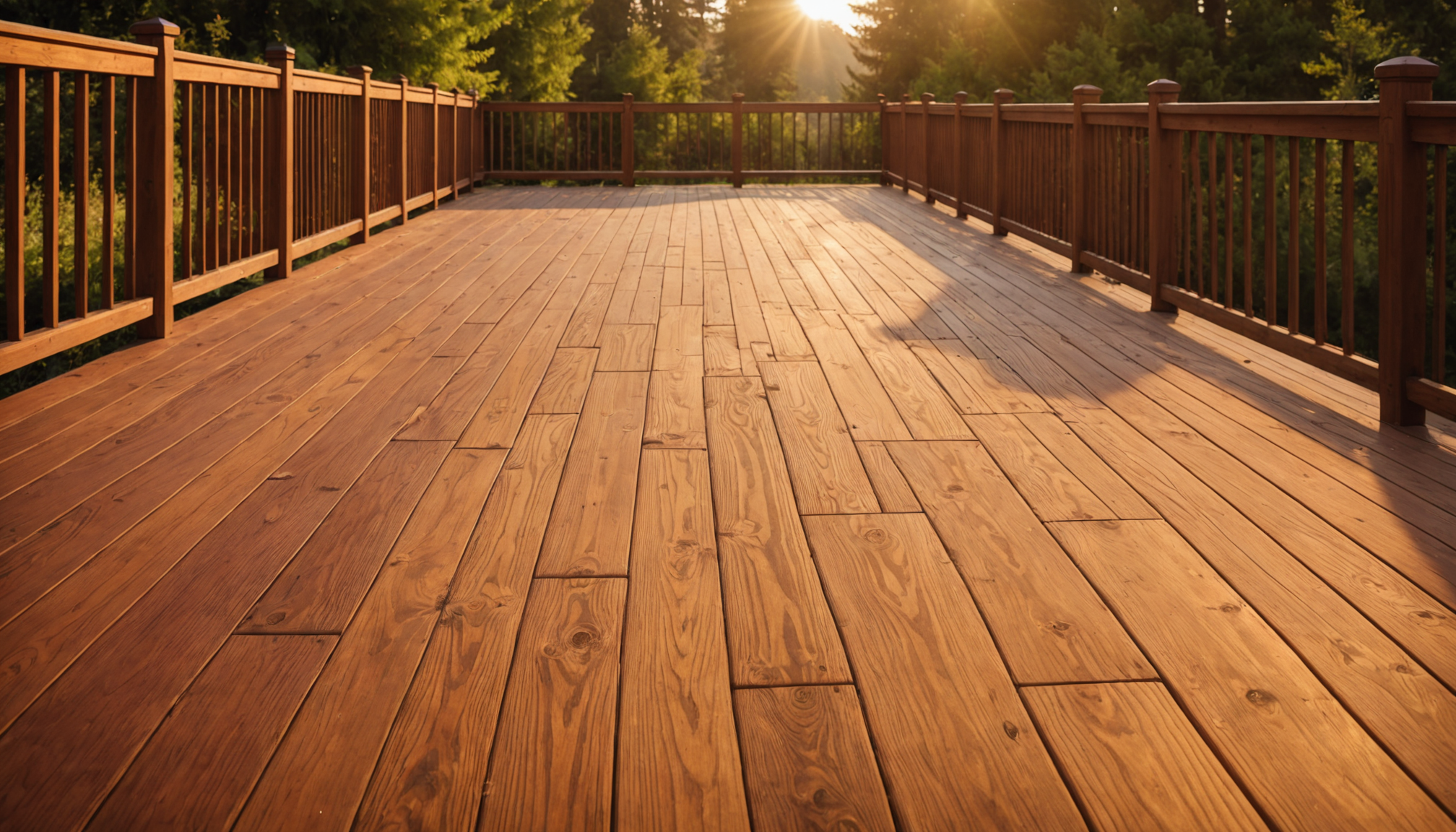When it comes to selecting the right material for your deck, understanding the various options available is essential. The choice of material will not only influence the aesthetic appeal of the deck but also its durability, maintenance requirements, and overall costs. Each material comes with its own set of benefits and drawbacks, making it crucial to thoroughly understand these options before making a decision.
There are several commonly used materials for decking, each offering unique characteristics:
- Wood: Often favored for its natural beauty, wood decking creates a warm and inviting outdoor space. Common types include cedar, redwood, and pressure-treated lumber. While wood has a timeless appeal, it does require regular maintenance, including staining and sealing, to protect against moisture and insects.
- Composite: Composite decking combines recycled wood fibers and plastics to create a durable, low-maintenance product. This material is resistant to rot, warping, and insect damage, making it a popular choice for homeowners seeking longevity and ease of care.
- Plastic: Made entirely from synthetic materials, plastic decking offers excellent resistance to weather and moisture, requiring little to no maintenance. This type of decking is available in a range of colors and textures, providing great flexibility in design.
- Aluminum: Known for its strength and lightweight properties, aluminum decking is highly durable and requires virtually no maintenance. It’s non-combustible and slip-resistant, making it a safe option. However, the metallic appearance may not appeal to all homeowners.
- Modified Wood: This innovative material undergoes a process that enhances the properties of the wood, including increased durability and stability. Modified wood maintains the aesthetic appeal of natural wood while offering improved performance characteristics.
To aid in comparing these options, consider the following table, which outlines key attributes of each material:
| Material | Natural Appearance | Durability | Maintenance | Cost |
| Wood | High | Moderate | High | Moderate |
| Composite | Moderate | High | Low | High |
| Plastic | Low | High | Low | Moderate |
| Aluminum | Low | Very High | Very Low | High |
| Modified Wood | High | High | Moderate | High |
Each of these decking materials offers different benefits and considerations, corresponding to both aesthetic preferences and practical needs. By understanding the distinct characteristics of each, homeowners can make informed decisions that will lead to a successful and satisfying decking project tailored to their specific requirements. With this foundational knowledge, evaluating other elements such as durability, maintenance needs, and environmental impact becomes more systematic and effective as you tailor your choice to suit your lifestyle and environment.
assessing durability and maintenance needs
When considering the durability and maintenance needs of your decking material, several factors come into play. Each type of decking material has unique properties that affect its longevity and the care required to keep it looking its best. Here’s a breakdown of what to consider for each material:
1. Wood
– Durability: Wood is susceptible to weathering, rot, and insect damage if not properly cared for. Over time, exposure to the elements can lead to warping and splitting.
– Maintenance Needs:
1. Regular Cleaning: Clean your wood decking regularly to remove debris and prevent mold and mildew buildup. This includes sweeping and occasional power washing.
2. Staining or Sealing: Apply a protective stain or sealant annually to help guard against moisture ingress and UV damage.
3. Inspection and Repair: Check for splinters, cracks, and other signs of wear. Replace damaged boards to maintain structural integrity.
2. Composite
– Durability: Composite decking is highly resistant to rot, warping, and insect damage thanks to its blend of wood fibers and plastic.
– Maintenance Needs:
1. Simple Cleaning: Periodic washing with soap and water is typically sufficient to keep composite decking looking good.
2. Mold Prevention: Although low-maintenance, composites can develop mold. Ensure proper ventilation to minimize mold occurrence.
3. Plastic
– Durability: Plastic decking resists weathering and moisture and will not splinter, crack, or break down over time.
– Maintenance Needs:
1. Occasional Washing: Like composite, plastic decking needs infrequent washing to keep it free of dirt and grim.
2. Color Fading: Be prepared for potential fading over time due to sun exposure, though this does not affect the material’s durability.
4. Aluminum
– Durability: Aluminum decking is incredibly strong and long-lasting, with excellent resistance to the elements.
– Maintenance Needs:
1. Minimal Care: Aluminum requires virtually no upkeep beyond occasional cleaning.
2. Inspection: Ensure aluminum surfaces remain free from scratches or dents, which, while rare, can compromise aesthetics.
5. Modified Wood
– Durability: Modified wood undergoes specific treatments to enhance its natural durability, providing improved resistance to decay and insects.
– Maintenance Needs:
1. Light Cleaning: Regular cleaning is essential. Sweep away debris and clean with water to retain its appearance.
2. Periodic Sealing: Depending on the modification process, some types need occasional sealing to enhance water resistance further.
By evaluating the durability and maintenance requirements of each decking material type, you can select one that aligns with your desired level of upkeep and long-term performance. Remember that investing time in regular care and inspection can significantly extend the lifespan of your deck and enhance its visual appeal over the years.
evaluating environmental impact
In recent years, the environmental impact of decking material choices has become an essential factor for many homeowners. Selecting a material that supports sustainability and reduces carbon footprint is not only a responsible choice for the planet, but it can also add long-term value to your home and provide peace of mind.
Wood is often seen as the traditional choice, but it’s important to consider how it’s sourced. Opting for wood certified by the Forest Stewardship Council (FSC) ensures that it is harvested sustainably, minimizing deforestation and promoting responsible land management. While wood is a renewable resource, it does have some downsides: it requires frequent maintenance and treatment with chemicals—such as stains and sealants—that can be harmful to the environment if not disposed of properly.
The development of composite decking has led to a material that is both durable and eco-friendly. Made from a blend of recycled wood fibers and plastics, composites prevent waste by repurposing materials that might otherwise end up in landfills. Furthermore, the manufacturing process for composite decking is often more energy-efficient than that of traditional wood. However, while composite materials eliminate the need for harmful chemical treatments, they are not biodegradable and have their own environmental drawbacks once they reach the end of their useful life.
Plastic decking, particularly those made from recycled plastics, ranks high in terms of environmental benefits. By utilizing post-consumer materials, plastic decking helps reduce the amount of plastic waste. Still, like composite, they are not biodegradable. It is crucial to check whether the manufacturer has a recycling or take-back program in place, ensuring the material does not become a pollutant at the end of its lifecycle.
Aluminum decking is exceptionally durable, with a long lifespan that reduces the need for regular replacement, thereby conserving resources over time. Aluminum is also highly recyclable, and the recycling process uses only a fraction of the energy required to produce new aluminum. However, initial energy consumption and emissions during production can be significant, so investigating the sourcing and production methods can provide insight into the overall environmental impact.
Lastly, modified wood represents a new frontier in eco-friendly decking. Through various treatment processes, modified wood achieves superior durability and rot resistance without the need for chemical preservatives. This not only extends the lifespan of the deck but also minimizes environmental pollution. As modified wood maintains the recyclability and carbon-sequestering benefits of natural wood, it has become increasingly popular among eco-conscious homeowners.
Understanding the environmental impact of different decking materials helps ensure a sustainable choice that aligns with your values and long-term goals. Prioritizing materials that reduce waste, conserve resources, and support responsible industry practices can play a significant role in minimizing your decking project’s ecological footprint while still delivering a beautiful and functional outdoor space.
comparing costs and budgets
When planning your decking project, understanding the financial implications of each material option is crucial. Costs can vary widely depending on the material chosen, not only in terms of initial purchase and installation but also concerning long-term maintenance and replacement needs. Therefore, it’s important to consider both the up-front and lifetime costs of your decking material.
Wood, often regarded as a budget-friendly option, typically requires a lower initial financial outlay compared to composite or aluminum alternatives. However, the need for regular maintenance such as staining, sealing, and occasionally replacing weathered or damaged boards can quickly increase total costs. Over the lifespan of a wood deck, these accumulated maintenance activities may approach or even surpass the initial price, so it’s essential to budget for these recurring expenses from the start.
Composite decking, while having a higher initial cost than wood, often proves to be more cost-effective in the long run. Its longevity and low maintenance requirements mean fewer annual expenses, and without the need for frequent staining or sealing, composites provide financial relief over time. It’s worth examining the variety of composite price points; premium versions may offer better warranties and added benefits like enhanced color retention or scratch resistance, which could further justify the cost.
Plastic decking falls somewhere in between wood and composite when evaluating costs. The absence of natural material components makes it highly resistant to the elements, ensuring minimal maintenance costs and fewer replacements over time. Initial investment is moderate, and if you consider the longevity and ease of upkeep, plastic can be a very economical choice for the right situation.
With aluminum decking, the initial cost can be high; however, its extreme durability and minimal upkeep requirements contribute to low lifetime costs. Aluminum does not require treatment or frequent repairs, markedly reducing ongoing expenses. For homeowners prioritizing long-term savings and hassle-free maintenance, aluminum can represent significant value despite the steep entry price.
Modified wood offers another alternative with a higher initial cost due to the specialized treatment processes it undergoes. These upfront costs are offset by the material’s enhanced durability and reduced maintenance requirements compared to untreated wood. Over time, the savings achieved through less frequent repairs and maintenance make modified wood a competitive option.
It’s crucial to evaluate project-specific factors when comparing these costs. Consider the size and complexity of your deck, local labor rates, and your timeline for return on investment. Additionally, exploring warranty options can provide peace of mind and potentially impact overall budget considerations. By conducting a comprehensive cost analysis that includes installation, maintenance, and potential replacement, you’ll be better equipped to select a decking material that not only fits your immediate budget but also offers enduring value over time.
selecting the best material for your project
When it comes to selecting the best material for your decking project, the decision involves more than just cost or aesthetic appeal; it requires a thoughtful balance of several elements that align with your unique needs and preferences. Begin by prioritizing what matters most to you: is it the natural beauty and authenticity of traditional wood, or the longevity and minimal upkeep of composite options? Consider the climate of your area and how it may affect the material’s performance—especially with factors like humidity, sun exposure, and seasonal changes.
The scale of your project also plays a crucial role in material selection. Larger installations might benefit from more durable, low-maintenance materials that can help reduce ongoing costs, whereas smaller decks might permit a splurge on premium wood or modified alternatives to maximize visual impact. Your choice should also reflect the deck’s intended use. If you often host gatherings, a slip-resistant and sturdy surface like aluminum might be appealing, while a cozy and warm wood surface may better suit a small, intimate space.
Additionally, lifestyle factors like willingness to commit to maintenance and having the tools and time for repairs or treatments can heavily influence your decision. For instance, if your free time is limited or you prefer hassle-free solutions, materials like composite or aluminum that demand minimal maintenance might be advantageous.
Finally, do not overlook the project’s integration into the existing environment and its ecological impacts. Consider how your chosen material harmonizes with the existing landscape, the architecture of your home, and any sustainability goals you may have. Taking these factors into account will guide you toward a material choice that not only meets your immediate functional needs but also contributes positively to your property and environment.
By evaluating these diverse considerations, you can confidently select the right decking material that complements both your practical requirements and aesthetic aspirations, leading to a successful and enjoyable outdoor living space that withstands the test of time.
—
In conclusion, selecting the right decking material requires a careful assessment of multiple factors including durability, maintenance, environmental impact, and cost. By weighing these aspects against your specific needs and preferences, you can make an informed decision that fulfills both your practical requirements and aesthetic aspirations. With the right choice, your deck can become a long-lasting and beautiful addition to your home, providing a welcoming space for relaxation and enjoyment for years to come.


